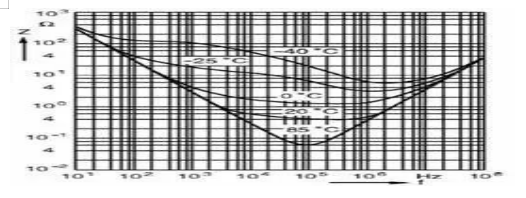What are the methods for selecting electrolytic capacitors?
As we all know, switching power supply is the main power source of today's information appliances, making an indelible contribution to the small and lightweight electronic equipment. Switching power supplies continue to be smaller, lighter, and more efficient, and are increasingly used in electronic devices, and the penetration rate is increasing. Correspondingly, electrolytic capacitors are required to be small and large in capacity, resistant to ripple current, high frequency and low impedance, high temperature and long life, and more suitable for high-density assembly.
Frequency characteristics and impedance
For the operation frequency of small and medium output power switching power supply, except for a few due to price limitation, 20~40kHz is still used, most of which are above 50kHz; the switching frequency of high power switching power supply is limited by the switching speed of the main switch (usually using IGBT). At 20~40kHz. Although the switching frequency is different, the output rectifying and filtering capacitors of the switching power supply have the same function, mainly filtering the ripple voltage component by using the filter capacitor to absorb the switching frequency and the current component of the higher harmonic frequency.
The filter capacitor used at the output of the switching power supply is not the same as the filter capacitor selected in the power frequency circuit. The common electrolytic capacitor used as a filter in the power frequency circuit has a ripple voltage frequency of only 100 Hz, and the charge and discharge time is On the order of milliseconds, in order to obtain a small pulsation coefficient, the required capacitance is as high as several hundred thousand microfarads. Therefore, the general purpose of low-frequency ordinary aluminum electrolytic capacitors is to increase the capacitance, the capacitance and loss tangent of the capacitor, and Leakage current is the main parameter to identify its advantages and disadvantages.
As an electrolytic capacitor for output filtering in a switching regulator power supply, since most switching power supplies operate in a square wave or rectangular wave state, they are rich in high-order harmonic voltages and currents, and the frequency of the sawtooth wave voltage is as high as several. Ten kilohertz, or even tens of megahertz, its requirements are different from those of low frequency applications. Capacitance is not the main indicator, and its impedance frequency characteristics are measured, as shown in Figure 1.

Figure 1 Impedance frequency characteristics of a 47μF/350V aluminum electrolytic capacitor
It can be seen from the figure that as the frequency increases, the capacitive reactance decreases and the inductive reactance rises. The frequency at which the capacitive reactance is equal to the inductive reactance and cancel each other is the resonant frequency of the aluminum electrolytic capacitor, and the impedance at this time is the lowest, leaving only the ESR. If the ESR is zero, then the impedance is also zero; the frequency continues to rise, the inductive reactance begins to be greater than the capacitive reactance, and when the inductive reactance is close to the ESR, the impedance frequency characteristic begins to rise, being inductive, starting from this frequency. The capacitor is an inductor in time.
Due to the manufacturing process, the larger the capacitance, the larger the parasitic inductance, the lower the resonance frequency, and the lower the frequency at which the capacitor is inductive. This requires it to have a low equivalent impedance in the operating frequency band of the switching regulator power supply. At the same time, for the internal power supply, due to the peak noise generated by the semiconductor device starting to work up to hundreds of kilohertz, it can also have good filtering effect. Generally, the ordinary low-frequency ordinary electrolytic capacitor is about 10 kHz, and its impedance begins to show inductivity, which cannot meet the requirements of switching power supply.
The electrolytic capacitor used for the output rectification of the switching power supply requires that the impedance frequency characteristic does not show an upward trend at 300 kHz or even 500 kHz. The electrolytic capacitor has a low ESR, which effectively filters out high frequency ripple and spike voltage in the switching regulator. Ordinary electrolytic capacitors begin to show an upward trend after 100 kHz, and the effect of switching power supply output rectification and filtering is relatively poor.
The ordinary CDII type 4700μF, 16V electrolytic capacitor, the ripple and spike for the switching power supply output filtering is not lower than the CD03HF type 4700μF, 16V high frequency electrolytic capacitor, and the ordinary electrolytic capacitor temperature rise is relatively high. When the load is abruptly changed, the transient response of a conventional electrolytic capacitor is much inferior to that of a high frequency electrolytic capacitor.
The switching power supply increases the high frequency of the operating frequency for high efficiency. In particular, the input filtering capacitor of the small high-output switching power supply requires high ripple and the output is low-impedance. To make the output filter capacitor low impedance at high frequencies, the equivalent series resistance must be reduced.
If you want to know more, our website has product specifications for the electrolytic capacitors, you can go to ALLICDATA ELECTRONICS LIMITED to get more information

